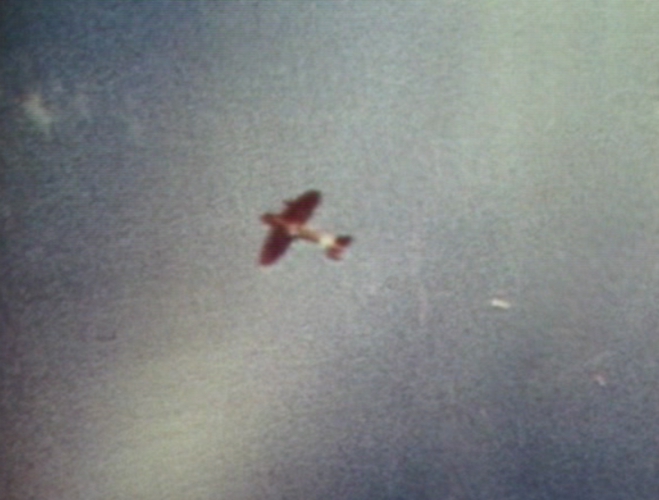
| Historical Information | ||||||||||||
| Caption | D3A1 carrier dive bomber in flight over Sand Island, Midway Atoll, 4 Jun 1942 ww2dbase | |||||||||||
| WW2-Era Location Name | Midway, US Pacific Islands | |||||||||||
| Date | 4 Jun 1942 | |||||||||||
| Photographer | John Ford | |||||||||||
| Source Information | ||||||||||||
| Source | ww2dbaseUnited States Navy | |||||||||||
| Related Content | ||||||||||||
| More on... |
| |||||||||||
| Photos on Same Day | 4 Jun 1942 | |||||||||||
| Licensing Information | ||||||||||||
| Licensing | Public Domain. According to the United States copyright law (United States Code, Title 17, Chapter 1, Section 105), in part, "[c]opyright protection under this title is not available for any work of the United States Government". Please contact us regarding any inaccuracies with the above information. Thank you. |
|||||||||||
| Metadata | ||||||||||||
| Added By | C. Peter Chen | |||||||||||
| Photo Size | 659 x 500 pixels | |||||||||||
Você gostou deste artigo ou achou este artigo útil? Se sim, considere nos apoiar no Patreon. Qualquer valor já vai ajudar! Obrigado. Por favor, ajude-nos a divulgar o site: Fique atualizado com WW2DB: |
Visitor Submitted Comments
2.  Bill says:
Bill says:
16 Oct 2016 07:02:35 PM
TWIST & TURN: GONNA BE A FLAMMER
Looks like this Val is inverted
and trying to evade those .50 caliber rounds fired from a US fighter. Like most
Japanese aircraft, the Aichi D3A "Val" had no armor protection for the crew or fuel tanks.
Most US pilots used what is called deflection shooting, that is shooting just a head of the target, so the slugs meet the aircraft at the same time.
The lightly armed D3A "Val"
had 2 x 7.7mm machine guns for the pilot and 1 x 7.7mm for the rear gunner still not enough to duke it out with a fighter...
16 Oct 2016 07:02:35 PM
TWIST & TURN: GONNA BE A FLAMMER
Looks like this Val is inverted
and trying to evade those .50 caliber rounds fired from a US fighter. Like most
Japanese aircraft, the Aichi D3A "Val" had no armor protection for the crew or fuel tanks.
Most US pilots used what is called deflection shooting, that is shooting just a head of the target, so the slugs meet the aircraft at the same time.
The lightly armed D3A "Val"
had 2 x 7.7mm machine guns for the pilot and 1 x 7.7mm for the rear gunner still not enough to duke it out with a fighter...
All visitor submitted comments are opinions of those making the submissions and do not reflect views of WW2DB.
Pesquisar WW2DB

Map
WW2-Era Location Name:Midway, US Pacific Islands
Latitude-Longitude:
28.2014, -177.3814
Foto Aleatória
Men of Chinese 67th Division raising the Chinese flag at the Chinese occupation headquarters in Osaka, Japan, 8 Sep 1945Estatísticas Atuais do Site
- » 1,181 biografias
- » 337 eventos
- » 45,111 entradas na linha do tempo
- » 1,247 navios
- » 350 modelos de aeronaves
- » 207 modelos de veículos
- » 376 modelos de armas
- » 123 documentos históricos
- » 261 instalações
- » 470 eventos
- » 28,469 fotos
- » 365 mapas
Citação Famosa da 2ª GM
"Goddam it, you'll never get the Purple Heart hiding in a foxhole! Follow me!"Captain Henry P. Jim Crowe, Guadalcanal, 13 Jan 1943
Apoie-nos
Por favor, considere nos apoiar no Patreon. Mesmo R$1 por mês já faz uma grande diferença. Obrigado!
Ou, por favor, nos apoie adquirindo alguns produtos do WW2DB na TeeSpring. Obrigado!
20 Jul 2015 07:00:36 PM
CANNON FODDER:
At the start of the Pacific War, Japanese aircraft
were lightly built and lacked armor protection for crew and fuel tanks. Once Allied pilots started to use new tactics against these aircraft Japanese losses started to mount.
It was a master that could avoid being shot down and live to fight another day. Short bursts from the heavy US .50 Caliber machine gun round, would be enough to rip into the wings and fuselage, this would break up the aircraft or turn it into a flaming torch.
LOSSES MOUNT: ONLY THE VERY, VERY BEST
As the war continued most of Japan's veteran crews were killed or wounded in battle and replaced with men that in pre-war Naval Pilot Training, would have been rejected. This wasn't due to their lack of flying skill or the academic training needed, the Imperial Navy couldn't keep up with the losses and didn't have a second-line pool of trained pilots.
Veteran pilots that survived the air battles were later needed as flight instructors were far to few.
Everything was up front and only the very, very best were taken for pre-war pilot training. Did you know that during WWII Japan produced almost 80,000 aircraft, while the United States produced over 300,000 aircraft. Japan was out produced and was able to train pilots faster than Japan.